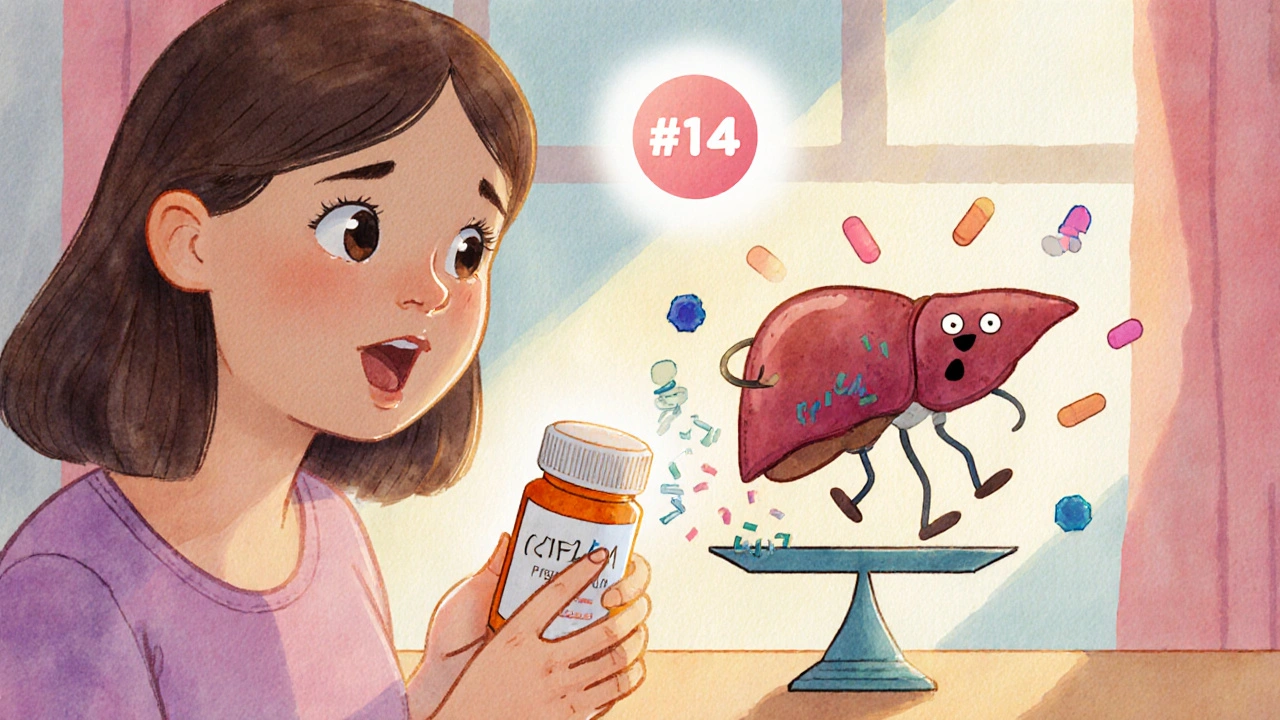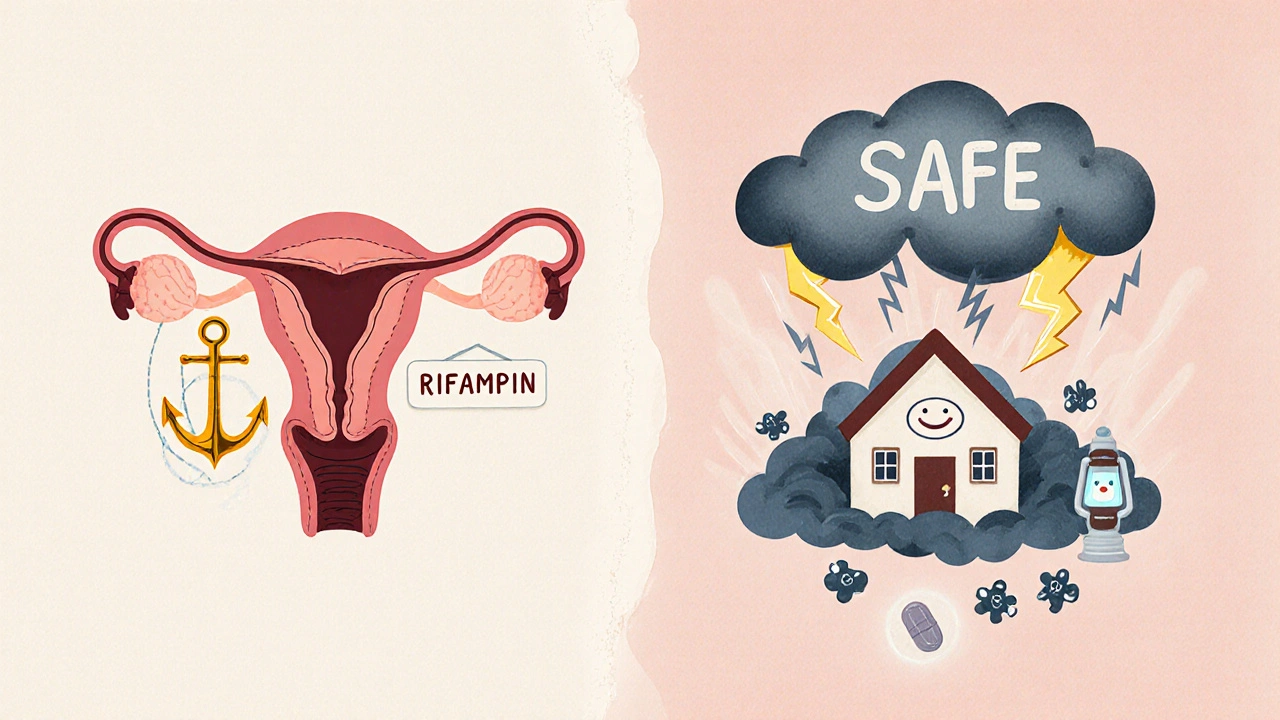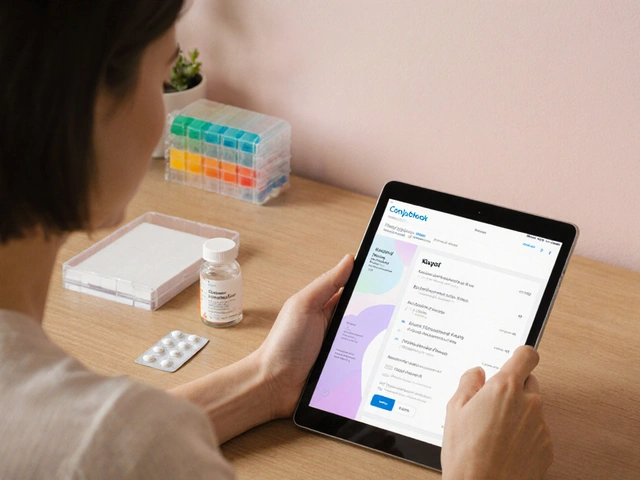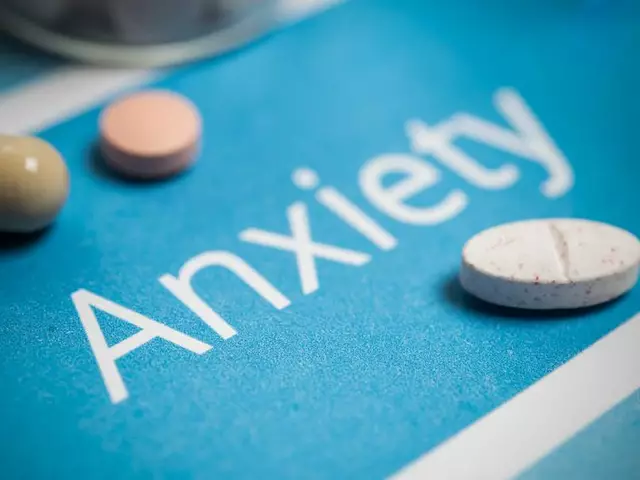21
Rifampin and Birth Control: What You Need to Know About Contraceptive Failure Risks

Rifampin Birth Control Timeline Calculator
Rifampin can make your birth control ineffective for weeks after you stop taking it. This tool calculates when you can safely stop using backup contraception based on your last dose date.
Remember: You need backup contraception for 28 days after your last dose of rifampin to prevent pregnancy.
When you're prescribed rifampin for tuberculosis or a stubborn staph infection, your main concern is getting better. But there's a hidden risk most people don't know about-your birth control might stop working. This isn't a myth, a rumor, or a warning on a label you skimmed over. It's a well-documented, clinically proven interaction that has led to real pregnancies in women who thought they were protected.
Why Rifampin Breaks Birth Control
Rifampin doesn't just kill bacteria. It also tricks your liver into speeding up the breakdown of hormones. Specifically, it turns on enzymes-CYP3A4-that are responsible for metabolizing estrogen and progestin, the two key ingredients in most oral contraceptives. When these enzymes go into overdrive, your body clears the hormones too fast. Instead of staying in your system long enough to prevent ovulation, the hormones get flushed out before they can do their job. Studies show this isn't a small effect. In pharmacokinetic trials, rifampin reduces the concentration of ethinyl estradiol (the estrogen in most pills) by 37% to 67%. Progestin levels drop by 27% to 52%. That’s not a slight dip-it’s enough to let ovulation happen. And when ovulation happens, pregnancy can follow.The Only Antibiotic That Really Does This
You’ve probably heard warnings about antibiotics and birth control from friends, pharmacists, or even your doctor. But here’s the truth: rifampin is the only antibiotic with solid, repeated evidence of causing contraceptive failure. Penicillin? Amoxicillin? Azithromycin? Tetracycline? None of them have been proven to interfere with birth control in controlled studies. Between 1970 and 1999, the UK’s Committee on Safety of Medicines received 117 reports of contraceptive failure linked to penicillins and tetracyclines. But when researchers looked closer, they found no consistent pattern. No drop in hormone levels. No increase in ovulation. Just coincidence-or other factors like vomiting, missed pills, or drug interactions with something else. Rifampin is different. Every single documented case of antibiotic-related contraceptive failure with strong evidence involved rifampin. The Canadian Journal of Infectious Diseases reviewed all available data in 1999 and found 100% of confirmed cases tied to rifampin. No other antibiotic came close.Rifabutin: The Lesser-Known Risk
If you’re on rifabutin instead of rifampin-sometimes used for MAC infections or TB in HIV patients-you’re not off the hook. Rifabutin also induces liver enzymes, but less powerfully. Studies show it reduces contraceptive hormone levels by about 20% to 30%. That’s not as bad as rifampin, but it’s still enough to raise the risk of ovulation. In one study of 12 women taking rifabutin and birth control pills, 4 developed breakthrough bleeding and elevated progesterone levels-signs their bodies were ovulating. That’s a 33% rate of physiological disruption. Not everyone gets pregnant, but the risk is real. Experts recommend backup contraception with rifabutin too, especially if you’re on a higher dose or have other risk factors.What About Other Birth Control Methods?
Not all hormonal birth control is affected the same way. Pills are the most vulnerable because they deliver low, daily doses of hormones that get broken down quickly. But what about patches, rings, or implants? The patch and ring work similarly to pills and are also affected by rifampin. The same enzyme induction applies. But implants like Nexplanon (etonogestrel) tell a different story. A 2023 study tracked 47 women using Nexplanon while taking rifampin. None got pregnant. The implant releases progestin slowly over years, keeping levels consistently high-even when the liver tries to break it down faster. Intrauterine devices (IUDs) are the safest bet. Copper IUDs don’t use hormones at all. They work by creating an inflammatory response in the uterus that stops sperm from reaching an egg. No liver enzymes involved. No hormone levels to mess with. That’s why the CDC and WHO now recommend copper IUDs as the first-line backup for women on rifampin.
How Long Do You Need Backup Contraception?
Here’s where most people get it wrong. You don’t just need backup while you’re taking rifampin. You need it for 28 days after your last dose. Why? Because rifampin doesn’t just hang around in your blood. It reprograms your liver. Even after you stop taking it, the enzyme induction lasts for weeks. Your liver keeps producing those extra CYP3A4 enzymes. It takes about 2 to 4 weeks for your body to return to normal. If you stop rifampin on Day 30 and go back to your pill on Day 31, you’re still at risk. The hormones won’t build up properly. You could ovulate. You could get pregnant. The CDC’s Medical Eligibility Criteria classifies combined hormonal contraceptives as Category 4 when used with rifampin-meaning the risks outweigh any benefits. That’s the highest risk category. No exceptions.What Should You Do?
If you’re prescribed rifampin and use hormonal birth control, here’s your action plan:- Stop relying on pills, patches, or rings during treatment and for 28 days after.
- Use a copper IUD if you can get one. It’s long-lasting, highly effective, and unaffected by rifampin.
- If an IUD isn’t an option, use condoms consistently and correctly every time you have sex.
- Don’t switch to another hormonal method thinking it’s safer-most still get broken down by the same enzymes.
- Ask your doctor about long-acting reversible contraception (LARC) before starting rifampin. It’s the best long-term solution.
Why Do So Many Doctors Miss This?
A 2017 survey found that only 42% of primary care doctors consistently warn patients about rifampin’s effect on birth control. Nearly 30% mistakenly told patients to use backup contraception for all antibiotics. That’s a huge problem. On one hand, women on rifampin are being left unprotected. On the other, countless others are being scared into using condoms or switching methods unnecessarily. The American College of Obstetricians and Gynecologists (ACOG) made it clear in 2019: “Non-rifamycin antibiotics do not reduce oral contraceptive effectiveness.” But many clinicians still don’t know that. Or they’re too busy to double-check.
The Bigger Picture: Global Health Gaps
This isn’t just a Western healthcare issue. Around 10 million people get tuberculosis every year globally. In sub-Saharan Africa, where TB is common and access to contraception is limited, this interaction creates a silent crisis. Women on rifampin may not even know they’re at risk. They might not have access to IUDs. They might not be told anything at all. Pharmaceutical companies now test every new hormonal contraceptive against rifampin before approval. The FDA and EMA require it. That’s because this interaction is too dangerous to ignore. It adds millions to development costs and delays new options by over a year. Yet, a 2022 study in the Journal of Women’s Health found that 63% of women prescribed rifampin received no proper contraceptive counseling. That’s not a gap in science. That’s a gap in care.What’s Changing?
There’s hope. New TB treatment regimens are being tested that avoid rifampin entirely. One 4-month regimen using high-dose rifapentine and moxifloxacin showed promising results in a CDC trial completed in 2022. If approved, it could reduce the number of women exposed to this risk. In the meantime, the safest path is clear: if you’re on rifampin, don’t trust your pill. Use a copper IUD or condoms. Talk to your doctor before you start the antibiotic-not after. This isn’t about being paranoid. It’s about being informed. Birth control failure isn’t a rare side effect here-it’s a direct, predictable consequence of a known drug interaction. And if you’re one of the women who gets pregnant because no one told you, it’s not your fault. It’s a system failure.Frequently Asked Questions
Does rifampin affect all types of birth control?
No. Rifampin only affects hormonal methods that rely on estrogen and progestin-like pills, patches, and vaginal rings. It does not affect copper IUDs, which work without hormones. Implants like Nexplanon may still work due to higher hormone doses, but evidence is limited. Always confirm with your doctor.
How long after stopping rifampin should I wait before going back on birth control?
Wait 28 days after your last dose. Rifampin keeps your liver enzymes turned on for weeks, even after the drug is gone. Going back on the pill too soon means your body will still break down the hormones too fast, leaving you unprotected.
Can I just take a higher dose of birth control to make up for it?
No. Doubling your pill dose or using a stronger patch won’t fix this. The liver enzymes break down the hormones faster regardless of how much you take. This isn’t a dosage issue-it’s a metabolic one. Only non-hormonal methods like condoms or a copper IUD are reliable.
Are there any antibiotics that don’t interfere with birth control at all?
Yes. Most antibiotics-including penicillin, amoxicillin, azithromycin, ciprofloxacin, and doxycycline-do not affect hormonal birth control. The only antibiotics proven to interfere are rifampin and, to a lesser extent, rifabutin. Don’t assume all antibiotics are the same.
What should I do if I got pregnant while on rifampin and birth control?
Contact your doctor right away. This interaction doesn’t increase the risk of birth defects, but it does mean you need urgent prenatal care. Also, report the case to your country’s drug safety agency-it helps improve guidelines and warnings for others.








